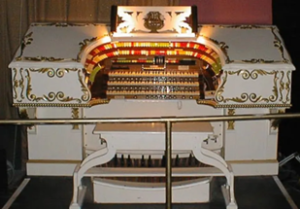The Keswick Möller Opus 5230

Built in 1928, this 3 manual 19 rank Möller Deluxe located at the Keswick Theatre, 291 North Keswick Avenue in Glenside, Pennsylvania is currently undergoing upgrading by TOSDV volunteers to get it concert ready. The sound of the Möller in this 1928 theatre is said to be magnificent! TOSDV looks forward to once again presenting this organ to the public in the future.

History of the Keswick Theatre and its Möller
The Keswick Theatre opened to the public on Thursday evening, December 27, 1928. The building was designed by Horace Trumbauer, one of the foremost designers of movie palaces which came into being during the decade of the roaring twenties. In contrast with the flamboyant French, Italian, and Spanish Renaissance palaces that dominated theatrical architecture at the time, the façade of the Keswick was Elizabethan in concept, a style reminiscent of Tudor England. The choice of architectural style was inspired by the semi-rural character of the developing suburb; so much so that the façade realized by Horace Trumbauer has survived virtually unchanged.
In contrast, the interior of the theatre was designed as an eclectic mix of elegant architectural styles. The Aeolian-Votey pipe organ with which the auditorium was equipped was supplied by the Aeolian Organ Company of Garwood, New Jersey and featured pipe work of an orchestral character and a dazzling array of tonal percussions and traps. A similar example of that builder’s work exists in the instrument at Longwood Gardens, the DuPont estate.
The current organ at the Keswick reflects the original. Constructed by the M.P. Möller Organ Company of Hagerstown, Maryland, it also was built in 1928, and is of a size similar to the original Aeolian. The organ, as now installed, is derived from the Möller originally installed in the Sedgwick Theatre in the Mount Airy section of Philadelphia. The instrument presently consists of nineteen ranks of contrasting tonality, a Marimba, Harp Celeste, Xylophone, Tubular Chimes, Glockenspiel, as well as all of the sound effects for silent film displayed in the stop list below. The command center is a special white console trimmed with gold, which is associated with the Style 150 Möller Theatre Organ. The console might be described as flamboyant, having evolved during the late nineteen twenties into a conspicuous display suitable for solo performances in the blaze of the spotlight.
Among the ranks of pipes in the Keswick organ worthy of special mention are the thunderous sixteen-foot Diaphone (the bottom twelve notes of the Diaphonic Diapason), which together with the Horn Diapason, provide the foundation needed to support the tonal structure of the organ. In sharp contrast, there is the whimsical Kinura, its piquant intonations which are so suited to the requirements of silent film accompanists in depicting oriental scenes and mimicking the muted brass of the jazz orchestra. The Tibia Clausa and Tibia Plena (both large flutes) in addition to adding weight to the foundation registers, yield the sound qualities that are typical of the theatre organ. They are of great emotional appeal, and so are useful in providing background for romantic settings. Still another class of tone is represented by the chorus reeds: English Post Horn, Cornopean, and French Trumpet. They project an emotional fire essential to the depiction of high drama. The Clarinet and English Horn of the Keswick Organ are imitative of their orchestral counterparts. And then, there are the still softer stops: Vox Humana, Gemshorn, and Gemshorn Celeste. The Vox Humana, conceived to convey the impression of the human voice, which has been jokingly described as having a goat-like bleat, nevertheless has an emotional appeal that endears it to audiences of many descriptions.
The two Gemshorn ranks in the Keswick Organ are especially worthy of mention. They are of a delicacy worthy of the finest concert organ and are rarely to be found in theatre instruments. Finally, the three string-toned ranks of pipes in the Keswick Organ cap the orchestral capabilities essential to the rendition of theatre music.
It would be remiss not to mention the dedication of the Keswick Theatre Organ Crew, among whom there exist a variety of skills. Countless hours and physical effort have been lavished on restoration of damaged parts which have suffered deterioration during years of exposure and neglect, on replacement of missing pipes, on correction of inappropriate previous substitutions of ranks and on adaptations essential to the functioning of the organ,
In passing, it should also not fail to be mentioned that some of the foregoing activities have resulted not only in restoring the complex electrical controls which are the brain of the Keswick Organ, but in development of an associated memory. At last, an artist can record any performance electronically and have it played back at will. Truly a benefit to accompany an ongoing labor of love.
Work continues to restore this organ to concert readiness, and TOSDV looks forward to again presenting it to the public.
___________________________________________________________________________________
The Magnificent Möller 3/19 Theatre Pipe Organ Opus 5230
Main Chamber (Left) Solo Chamber (Right)
French Trumpet 8` Post Horn 8`
Tuba Harmonic 16` English Horn 8`
Clarinet 8` Kinura 8`
French Horn 8` Vox Humana 8`
Horn Diapason 8` Viole D` Orchestre 8`
Gemshorn 8` Viole D` Orchestre Celeste II 8`
Gemshorn Celeste 8` Diaphone 16`
Viole 16` Tibia Clausa 16
Tibia Plena 16` `
Concert Flute 16`
Tuned Percussions
Harp Celesta Cathedral Chimes Glockenspiel Xylophone
Upright Piano (unenclosed)
Toy Counter
Tambourine Castanets Bass Drum Snare Drum
Kettle Drum Cymbal Triangle Chinese Gong
Sound Effects (Main Chamber Only)
Police Siren Auto Horn Boat Whistle Bird Call